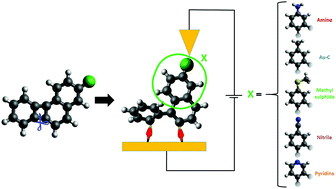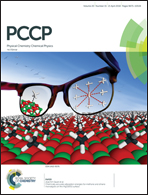Direct Au–C contacts based on biphenylene for single molecule circuits†
Abstract
We propose a novel platform for stable and highly conducting single molecule electronics and characterize its mechanical, electronic and conducting properties using ab initio simulations. We study a biphenylene-based molecular architecture on gold and consider that the antiaromatic instability of biphenylene leads to the breaking of internal carbon–carbon bonds and subsequent formation of Au–C covalent bonds with the substrate. In the resulting conformation the conjugated rings have a large twist angle and stand almost upright on the surface. The top contact is realized by functionalizing one end of the biphenylene unit with a chemical linker group, which in the adsorbed geometry is positioned far from the surface. We consider several linker terminations for this top contact, which is approached in our simulations by a gold tip. Using Density-Functional Theory (DFT) and Non-Equilibrium Green's Function (NEGF) methods, we quantify the mechanical and electron transport properties of the molecular junction and discuss their relationship with the nature of the linker group. Our results show that this biphenylene-based platform is very stable and provides high electronic transparency to current flow, demonstrating its potential in single molecule conductance studies.



 Please wait while we load your content...
Please wait while we load your content...